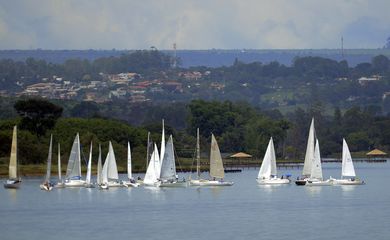Unesco proposes nature-based solutions for water management

The United Nations Educational, Scientific and Cultural Organization (Unesco) is launching its 2018 United Nations World Water Development Report during the opening ceremony of the 8th World Water Forum on Monday (Mar. 19), in Brasília. The document favors nature-based solutions (NBS), which use or simulate natural processes to enhance water management across the globe.


Angela Ortigara, official for Unesco’s World Water Assessment Program.
The study shows that, despite the spread of technology for the conservation and rehabilitation of natural ecosystems, these processes account for less than 1% of investment in infrastructure for the management of water resources. Angela Ortigara, official for Unesco’s World Water Assessment Program, says that the publication aims to encourage the adoption of NBSs for water management.
“What happens is that people often don’t take nature into account as an option for managing floods or prevent drought spells, for example—because it may be seen as difficult, not pragmatic, or because they lack knowledge. However, what we want to show in this report is that big infrastructure projects are not necessarily required to improve water management,” Ortigara said in an exclusive interview with the Brazil Communication Company, EBC.
Unesco’s report indicates that traditional approaches prevent sustainable water security from being attained. Nature-based solutions, on the other hand, work directly with nature, as opposed to against it, which is why they are the best way to go beyond traditional approaches and boost gains in social, economic and water efficiency in water management. “NBS shows particular promise in achieving progress towards sustainable food production, improved human settlements, access to water supply and sanitation services, and water-related disaster risk reduction. They can also help to respond to the impacts of climate change on water resources,” the publication reads.
“The report wants people to open their eyes to solutions that may not be clear from the engineering viewpoint. They may not be known, but they could bring about innovative ideas. If a decision stipulates the reforestation of an area, the first thing you may think is: this area will be covered, will be populated by animals, but will also help reload subterranean water, the aquifers,” Ortigara argued. “There are a number of benefits difficult to be quantified economically, and maybe this is one of the reasons why these solutions haven’t been used. However, they’re benefits that should be considered in the long run,” she went on to say.
Among the examples listed in the publication is the expansion of dry toilets, which refrain from discharging waste in pipes connected to sewage treatment centers and rivers and produces an organic compost. In a proposed solution with a broader scope, the report mentions the experience of sponge cities in China, in which the rainwater is absorbed quickly and safely.
Economy
The report’s nature-based solutions support “circular economy,” regarded as restorative and regenerative, which seeks to reduce wastage and prevent pollution, also by means of reusing and recycling. Also, the technology supports the concepts of green growth and green economy, which promote the sustainable use of natural resources and avail themselves of natural processes as the foundation of economies. “The application of NBS for water also generates social, economic and environmental co-benefits, including improved human health and livelihoods, sustainable economic growth, decent jobs, ecosystem rehabilitation and maintenance, and the protection and enhancement of biodiversity,” the text reads.
The world’s demand for water is reported to have escalated at a yearly rate of 1% due to population growth, economic development, and new consumption patterns, among other factors, and is expected to surge significantly in the coming two decades. At the same time, the world’s water cycle is growing more and more intense as a result of climate change, with already humid or dry regions becoming increasingly extreme.
Today, 3.6 billion people (nearly half of the population on the planet) are believed to live in areas with potential water scarcity at least for a month in the year. This figure may soar to around 4.8 billion–5.7 billion by 2050.
Challenges
The degradation of ecosystems is among the greatest challenges in water management, Unesco believes. The organization estimates that, since the year 1900, 64% to 71% of the natural wetland area worldwide has been lost due to human activity. “All these changes have had major negative impacts on hydrology, from local to regional and global scales.”
Another challenge is water quality. Since the 90s, water pollution aggravated in nearly all of the river in Latin America, Africa, and Asia. The report forecast the further worsening of water quality, which is expected to intensify threats to human health, the environment, and social development.
“The greatest increases in exposure to pollutants are expected to occur in low- and lower-middle income countries, primarily because of higher population and economic growth and the lack of wastewater management systems,” the report says.
The number of people under risk of flood is expected to increase from the current 1.2 billion to some 1.6 billion in 2015—about 20% of the world population. “The population currently affected by land degradation/desertification and drought is estimated at 1.8 billion people, making this the most significant category of natural disaster based on mortality and socio-economic impact relative to gross domestic product (GDP) per capita.”
Land use
Instead of seeing vegetation as a water consumer, the report argues that it should be viewed as a water recycler. “Globally, up to 40% of terrestrial rainfall originates from upwind plant transpiration and other land evaporation, with this source accounting for most of the rainfall in some regions.”
“Land use decisions in one place may therefore have significant consequences for water resources, people, the economy and the environment in distant locations—pointing to the limitations of the watershed (as opposed to the ‘precipitationshed’) as the basis for management,” the text also reads.
As an alternative, the report mentions the partnership between traditional technology with green infrastructure, “which uses natural or seminatural systems such as NBS to provide water resources management options with benefits that are equivalent or similar to conventional gray (built/physical) water infrastructure.”
“In some situations, nature-based approaches can offer the main or only viable solution (for example, landscape restoration to combat land degradation and desertification), whereas for different purposes only a gray solution will work (for example supplying water to a household through pipes and taps). In most cases, however, green and gray infrastructure can and should work together.”
Green infrastructure is believed to be capable of implementing major risk-reducing measures. The combination of green and gray infrastucture may lead to both cost and risk reduction. “NBS are able to enhance overall water security by improving water availability and water quality while simultaneously reducing water-related risks and generating additional social, economic and environmental co-benefits. They allow for the identification of win-win outcomes across sectors,” the text says.
Investment
The research study also argues that NBSs “do not necessarily require additional financial resources but usually involve redirecting and making more effective use of existing financing. Investments in green infrastructure are being mobilized thanks to the increasing recognition of the potential of ecosystem services to provide system-wide solutions that make investments more sustainable and cost-effective over time.”
“If you have to make a decision in water management, I’d say: please consider things that are different from the usual. Think of greener solutions, which can bring benefits not just to taking water from A to B, but something that can generate benefits for the environment along the way as well,” Ortigara remarked. “It’s necessary, especially for a large country like Brazil, where we always take for granted that we have lots of water, that it’s enough for everything, and then we see something like what happened in 2015, the drought in São Paulo, and we keep wondering why,” she added.
Unesco Project Official Massimiliano Lombardo says that, in link with the information disclosed in the report, “human beings can partner up with nature, instead of fighting it and trying to make it conform to our needs.” In his view, the needs of nature should be accommodated—as for water, nature’s need to spread and inundate a plain, for instance, as this is crucial to preserve the quality and quantity of water, to be used by people later on.
Publication
The World Water Development Report – WWDR is a yearly publication with a focus on strategic water-related issues. The document provides an overview of the state of drinking water resources across the world and aims to provide sustainable tools to be used by decision makers.
Translated by Fabrício Ferreira
Fonte: Unesco proposes nature-based solutions for water management






